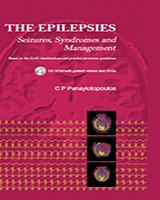From: Chapter 4, Principles of Therapy in Epilepsies

NCBI Bookshelf. A service of the National Library of Medicine, National Institutes of Health.
Main adverse reactions of AED, which may be serious and sometimes life-threatening
| AED | Main adverse reactions | Serious and sometimes life threatening reactions35,37 |
|---|---|---|
| Carbamazepine | Idiosyncratic (rash)*, sedation, headache, ataxia, nystagmus, diplopia, tremor, impotence, hyponatraemia, cardiac arrhythmia | Stevens-Johnson syndrome, AHS, hepatic failure, haematological |
| Clobazam | Severe sedation, fatigue, drowsiness, behavioural and cognitive impairment, restlessness, aggressiveness, hypersalivation and coordination disturbances. Tolerance and withdrawal syndrome | No |
| Clonazepam | As of clobazam | No |
| Ethosuximide | Idiosyncratic (rash)*, gastro-intestinal disturbances, anorexia, weight loss, drowsiness, photophobia and headache | Stevens-Johnson syndrome, AHS, renal and hepatic failure, haematological |
| Gabapentin | Weight gain,** peripheral oedema, behavioural changes | No |
| Lamotrigine | Idiosyncratic (rash)*, tics, insomnia, dizziness, diplopia, headache, ataxia, asthenia | Stevens-Johnson syndrome, AHS, hepatic failure |
| Levetiracetam | Irritability, behavioural changes, insomnia, asthenia, dizziness. | No |
| Oxcarbazepine | Idiosyncratic (rash)*, headache, dizziness, weakness, nausea, somnolence, ataxia and diplopia, hyponatraemia | AHS, haematological |
| Phenobarbitone | Idiosyncratic (rash)*, severe drowsiness, sedation, impairment of cognition and concentration, hyperkinesia and agitation in children, shoulder-hand syndrome | Stevens-Johnson syndrome, AHS, haematological |
| Phenytoin | Idiosyncratic (rash)*, ataxia, drowsiness, lethargy, sedation, encephalopathy, gingival hyperplasia, hirsutism, dysmorphism, rickets, osteomalacia | Stevens-Johnson syndrome, AHS, renal and hepatic failure, haematological |
| Tiagabine | Stupor or spike-wave stupor, weakness | No |
| Topiramate | Somnolence, anorexia, fatigue, nervousness, difficulty with concentration/attention, memory impairment, psychomotor slowing, metabolic acidosis, weight loss,** language dysfunction, renal calculi, acute angle-closure glaucoma and other ocular abnormalities, paraesthesia | Hepatic failure, anhidrosis*** |
| Valproate | Nausea, vomiting, dyspepsia, weight gain,** tremor, hair loss, hormonal in women. | Hepatic and pancreatic failure |
| Vigabatrin | Fatigue, drowsiness, weight gain,** behavioural changes | Irreversible visual field defects |
| Zonisamide | Idiosyncratic*, drowsiness, anorexia, irritability, photosensitivity, weight loss,** renal calculi | Stevens-Johnson syndrome, AHS, anhidrosis*** |
AHS= Anticonvulsant hypersensitivity syndrome which is a potentially fatal but rare reaction, manifests as rash, fever, tender lymphadenopathy, hepatitis, and eosinophilia.42–44 There is usually cross-sensitivity between AEDs, which have the potential to cause AHS; these AEDs should be avoided in patients who have developed idiosyncratic reactions to one or another drug.
The appearance of skin rash mandates immediate discontinuation of the responsible agent because it may progress to Stevens-Johnson syndrome and anticonvulsant hypersensitive syndrome.
The risks of obesity are emphasised routinely in the media in the United States and other industrialized countries where obesity has become epidemic. Patients and particularly women should be informed of AEDs that are likely to cause weight gain (gabapentin, pregabalin, valproate and vigabatrin). Conversely, topiramate and zonisamide may cause significant weight loss, which can be relentless. Lamotrigine, levetiracetam and phenytoin are weight neutral AEDs. 45
Hypohidrosis (in most cases anhidrosis=inability to sweat) is a rare but serious adverse effect of topiramate and zonisamide probably due to a reduction in carbonic anhydrase isoenzymes II and IV. Children particularly in warm environments are at higher risk.46–48
From: Chapter 4, Principles of Therapy in Epilepsies

NCBI Bookshelf. A service of the National Library of Medicine, National Institutes of Health.